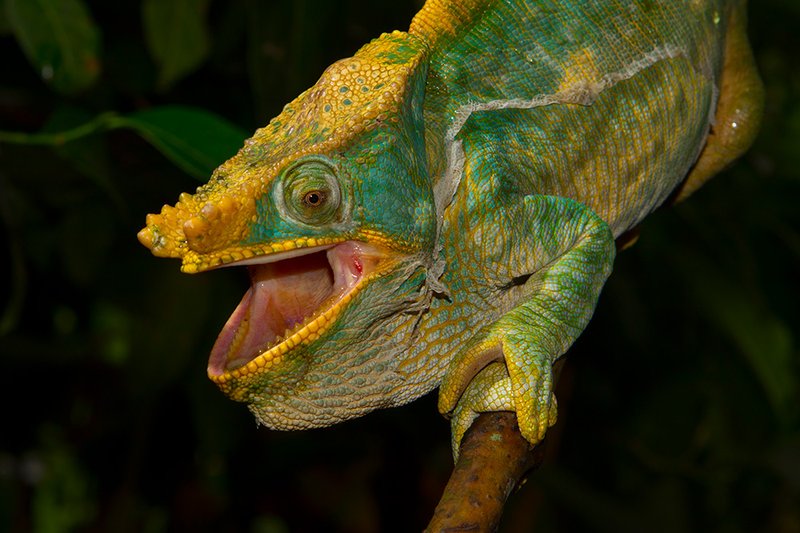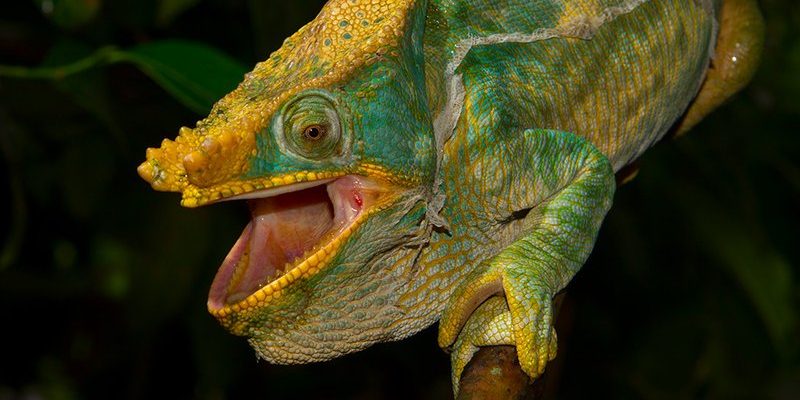
Here’s the thing: every reptile has its own quirks. Some are social butterflies, while others prefer to be lone wolves. Parson’s chameleons, specifically, are known for being somewhat solitary. But can they cohabitate with their reptile cousins? Let me explain what you need to know if you’re considering mixing your Parson’s chameleon with other reptiles.
Understanding Parson’s Chameleon Behavior
Parson’s chameleons are fascinating creatures. Native to Madagascar, these lizards are known for their ability to change color—an impressive skill that helps them regulate their body temperature and communicate. Generally, they thrive in a peaceful, quiet environment. Their natural instinct is to avoid confrontation, which can be tricky when it comes to sharing a living space with other reptiles.
One important thing to keep in mind is that Parson’s chameleons aren’t known for being the most social reptiles out there. They tend to prefer living alone, primarily because their aggressive behavior can trigger stress. If a chameleon feels threatened, it might change its color not just for display but out of fear. Think of it this way: if you’ve ever felt crowded at a party, you know how important personal space can be!
Suitability for Mixed Habitats
Many reptile enthusiasts wonder if it’s feasible to house a Parson’s chameleon with other reptile species. In most cases, these chameleons aren’t the best roommates. Their solitary nature means they often don’t appreciate sharing their space. This doesn’t mean you can’t try, but it’s essential to approach this situation with caution.
When mixing reptiles, factors like size, temperament, and habitat requirements are crucial. For instance, trying to keep a small, more docile reptile with a Parson’s chameleon might spell trouble: a nervous chameleon might see the smaller reptile as a threat and react defensively. Remember, you’re not just focusing on size; you’re also looking at compatibility. It’s like matching different personalities in a group—some get along great, while others just don’t mesh well.
Potential Risks of Cohabitation
Sharing space with a Parson’s chameleon can come with risks. First off, stress is a notable concern. Reptiles can experience stress from overpopulation, incompatible species, or territorial disputes. If your chameleon feels threatened or out of control in its environment, it could lead to a decline in health.
Another significant risk is aggression. Parson’s chameleons are known to be territorial, particularly males. If introduced to another male reptile, you could end up with a showdown—think of it as a turf war in your terrarium! In some cases, this aggression can result in injuries. It’s a valid concern that can affect the well-being of all reptiles involved.
Lastly, there’s the risk of disease transmission. Mixing species can increase the chance of spreading bacteria or parasites. Even if the other reptiles seem perfectly healthy, they might carry something that could harm your chameleon. Keeping their living spaces separate can help avoid such issues.
Creating the Right Environment
If you’re still keen on the idea of introducing a Parson’s chameleon to your reptile family, creating the right environment is vital. First, ensure that each reptile has its own separate territory. This separation helps prevent territorial disputes and reduces stress. You might think of it like creating personal ‘zones’ in a shared apartment—everyone needs their space to feel comfortable and safe.
When setting up a shared habitat, use barriers like mesh dividers or different enclosures. This setup allows reptiles to see each other without direct contact, giving them the chance to acclimate to each other’s presence. Also, consider their habitat requirements: each reptile has specific needs for temperature, humidity, and lighting. Make sure to meet those needs to create a safe, healthy environment.
Don’t forget about enrichment! Provide plenty of hiding spots and climbing structures for your chameleon to explore. Incorporating plants and branches can give your chameleon a sense of security. After all, who wouldn’t want a cozy nook to relax in?
Signs of Stress in Parson’s Chameleons
Recognizing signs of stress in your Parson’s chameleon is essential for its well-being, especially if you’re introducing them to other reptiles. Pay close attention to their behavior. If your chameleon starts to hide more often or displays aggressive colors, these can be signals that it’s feeling the pressure.
Additionally, changes in appetite can be a red flag. If your chameleon refuses its favorite food or loses interest in eating altogether, this may point to stress or discomfort in its environment. It’s important to act quickly in these situations. If you notice these signs, it might be time to reassess the living arrangements.
Physical symptoms like closing its eyes frequently or excessive puffing up can also indicate a stressed chameleon. Remember, a happy chameleon is a healthy chameleon! By monitoring their behavior closely, you can ensure a safe environment for your beloved reptiles.
Alternatives to Cohabiting with Other Reptiles
If it becomes clear that your Parson’s chameleon isn’t adjusting well to other reptiles, consider some alternatives. One popular option is to keep the chameleon in a solo habitat. This decision allows for a stress-free environment where the chameleon can thrive without the pressure of sharing its space.
Another alternative is to create a diverse but non-overlapping pet family. Instead of introducing another reptile, consider other pets like small mammals or amphibians, as long as they meet the particular care requirements and habitat needs. Each type of pet can have its own specialized enclosure, creating a wonderful, diverse pet ecosystem in your home.
Moreover, you could also focus on enriching your chameleon’s environment. Providing stimulating activities and interactions can help keep your chameleon happy and engaged without needing a roommate. Think toys, climbing structures, or even daily handling for socialization.
Final Thoughts on Parson’s Chameleons and Other Reptiles
So, do Parson’s chameleons get along with other reptiles? The answer isn’t a simple yes or no. While there’s potential for cohabitation, it comes with risks that might outweigh the benefits. Understanding their behavior, creating a suitable environment, and recognizing signs of stress are crucial steps in ensuring a healthy, happy life for your chameleon.
Ultimately, every reptile is unique. If you decide to introduce a Parson’s chameleon to your other pets, proceed with caution, prioritize their well-being, and always be ready to adjust if necessary. Your chameleon’s happiness—or lack thereof—can make all the difference in creating a harmonious reptile household.

